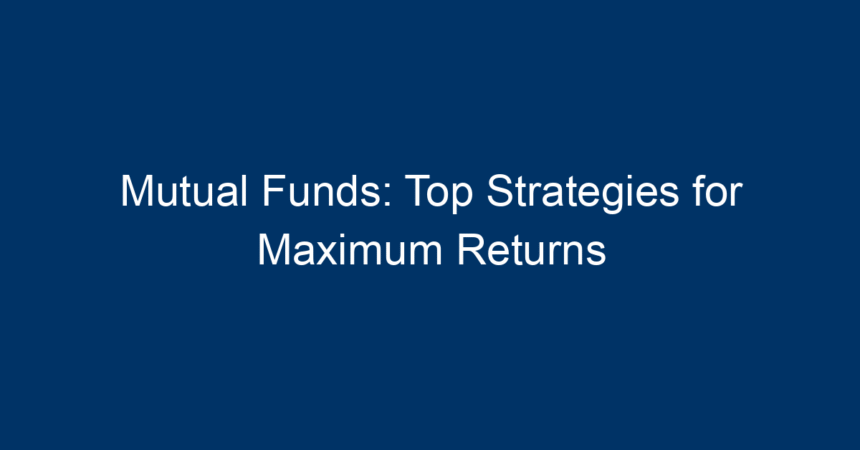In the realm of investing, mutual funds have emerged as a powerful vehicle for wealth accumulation. With the potential to deliver considerable returns, they allow both novices and seasoned investors to participate in the stock market without the need for extensive knowledge or large capital. In this article, we will explore the top strategies for maximizing returns through mutual funds, ensuring you make informed decisions that align with your financial goals.
Understanding Mutual Funds
Before delving into the strategies, let’s first understand what mutual funds are. Mutual funds pool money from multiple investors to purchase a diversified portfolio of stocks, bonds, or other securities. Managed by professional portfolio managers, these funds offer an opportunity to invest in various market segments without having to manage individual stocks.
The key advantages of mutual funds include:
- Diversification: Reduces risk by spreading investments across various assets.
- Professional Management: Investors benefit from the expertise of fund managers.
- Liquidity: Mutual funds can be easily bought or sold.
- Accessibility: Minimum investment amounts are generally lower compared to direct stock purchases.
Choosing the Right Fund
Assess Your Risk Tolerance
The first step in maximizing returns is to assess your risk tolerance. Mutual funds vary significantly in terms of risk, with options ranging from conservative bond funds to aggressive equity funds. Knowing your risk appetite will guide you toward funds that align with your investment strategy.
Understand Fund Types
- Equity Funds: Invest primarily in stocks. Suitable for long-term growth but come with higher volatility.
- Debt Funds: Invest in fixed-income securities. Generally more stable, offering lower returns.
- Balanced Funds: Combine equities and debt, providing a balanced risk-return profile.
- Index Funds: Mimic the performance of a market index. Low-cost and passive management make them attractive for many investors.
Selecting the right fund type is crucial to achieving maximum returns, as each fund serves a different investment purpose.
Top Strategies for Maximizing Returns on Mutual Funds
1. Regular Investments Through SIPs
One of the most effective strategies to maximize returns is through Systematic Investment Plans (SIPs). SIPs allow investors to invest a fixed amount regularly, usually monthly.
Benefits of SIPs:
- Rupee Cost Averaging: You buy more units when prices are low and fewer when prices are high, averaging out your purchase cost.
- Disciplined Approach: Promotes disciplined investing, reducing the temptation to time the market.
Investors who have adopted SIPs often see better long-term returns due to the compounding effect.
2. Rebalance Your Portfolio
Market conditions change, and so should your investment strategy. Rebalancing involves adjusting your fund allocations to maintain your desired risk level.
How to Rebalance:
- Set an Interval: Regularly assess your portfolio, ideally once a year.
- Use Target Allocations: Determine an ideal allocation for each fund type based on your risk tolerance and stick to it.
Rebalancing ensures that your portfolio doesn’t become too risky as certain assets appreciate more than others.
3. Focus on Long-Term Goals
Investing in mutual funds should be a long-term commitment. Trying to time the market or chasing short-term gains can lead to losses.
Long-Term Benefits:
- Compounding Returns: The growth on your investment builds upon previous gains, magnifying returns.
- Less Stress: Focusing on long-term performance reduces the emotional rollercoaster associated with short-term market fluctuations.
4. Analyze Fund Performance
Choosing the right mutual fund requires diligent analysis of performance history.
Factors to Consider:
- Historical Returns: Review 1-, 3-, and 5-year performance benchmarks.
- Expense Ratios: Lower expense ratios mean higher net returns. Be mindful of how fees affect your overall performance.
- Manager Tenure and Style: A consistently good fund manager can significantly impact fund returns.
Using these parameters will lead you to funds that historically perform well.
5. Stay Informed About Market Trends
Understanding market conditions can guide your investment decisions.
Tips for Staying Informed:
- Follow Financial News: Subscribe to financial journals or websites that provide insights into market developments.
- Attend Webinars/Seminars: Engage with financial experts through workshops for deeper insights.
Being informed will enhance your ability to make timely adjustments to your investment portfolio.
6. Tax Considerations
Tax implications can significantly affect your returns. Different mutual funds are taxed differently, affecting your overall investment strategy.
Capital Gains Tax:
- Equity Funds: Long-term capital gains (held over a year) are taxed at 10%, making them attractive for long-term investors.
- Debt Funds: Long-term capital gains are taxed at 20% with indexation benefits.
Understanding how taxes impact your returns can guide you in choosing the right time to sell or hold your investments.
Common Pitfalls to Avoid
To truly maximize returns from mutual funds, avoid these common mistakes:
1. Overtrading
Frequent buying and selling can lead to higher transaction costs and tax liabilities, ultimately eroding returns.
2. Ignoring Fund Objectives
Each fund has a specific investment mandate. Ensure your investments align with these objectives to avoid losses.
3. Emotional Decision-Making
Investing based on market emotions can lead to poor choices. Stick to your strategic plan and review it regularly, rather than reacting impulsively to market changes.
Conclusion: Take Action for Maximum Returns
Maximizing returns from mutual funds is not just about choosing the right fund; it’s about implementing a strategic plan tailored to your financial goals and risk tolerance. By employing strategies like regular investments through SIPs, portfolio rebalancing, and staying informed about market conditions, you can significantly enhance your investment outcomes.
Actionable Insights:
- Start a SIP in a fund that meets your risk profile.
- Review your portfolio at least once a year.
- Monitor financial news and stay educated on market trends.
- Consult with a financial advisor if you are unsure about your choices.
By taking these actionable steps, you will be well on your way to maximizing returns on your mutual fund investments. Remember, patience and informed decision-making are key to financial success in the ever-changing landscape of investing.




